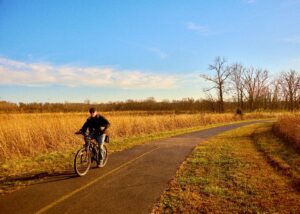
A man rides a bike through one of the parks within the Five Rivers system. | Credit: Five Rivers Metroparks.
Leave No Trace.
Ohio has 76 state parks. There are many pathways to give back to each one! The first thing you can do is leave no trace. Parks and trails should look the same on your way out as they did coming in, if not better. “Leaving no trace” could include picking up trash you come across or making sure that any and all unattended firepits are put out. For more information on the principles behind LNT, visit: https://lnt.org.
Be respectful of wildlife.
Take great care and stay respectful of wildlife. While it’s neat to encounter animals you might not normally see, it’s important to remember our parks are their home, and they should be treated as such. Never feed wildlife, as it can cause them to disregard fear of human interaction and could potentially lead to harm.
Other ways to give back.
If you’re looking for a more concrete way to give back, there are plenty of resources at your disposal. The Ohio Department of Natural Resources has a webpage that covers volunteer opportunities for prospective applicants, ranging from campground hosts, to hunting education, to water quality services.
In a statement, ODNR Press Secretary Karina Cheung said that “through Ohio Income Tax Refund donations, Ohioans can donate to Ohio’s State Nature Preserves and Scenic Rivers or Wildlife Diversity funds. Donations have helped to remove invasive species, establish nature preserves, as well as conservation projects to restore a variety of wildlife such as bald eagles, eastern hellbenders, mussels, and so much more.”
Check with officials at your local state and metropark systems for more up to date, localized information on ways to donate and volunteer. ODNR also accepts donations of equipment, material and other services that may benefit the department.
Education and awareness efforts matter.
Lauren Lemons, a marketing coordinator for Five Rivers Metroparks in Montgomery County, Ohio, said that while donations and volunteers are always appreciated, education and awareness are one of the primary efforts of many systems.
“We host outdoor recreation programs that really help people understand how to get out and hike,” Lauren said. “Our recreation specialists do a really good job about educating people how to be safe on trails, including Leave No Trace etiquette as well as small tips, like walking through mud instead of around it, so you don’t widen a trail.”
A surefire way to get involved is to get hands on experience! Lauren also said that people who are interested in conservation efforts can do so through volunteering, whether directly through the park or with an unaffiliated organization.
Help by stopping the spread of invasive species in your own backyard.
You can also support Ohio’s local and state parks from afar by being aware about invasive species. Honeysuckle, callery pears and spotted lanternflies are three increasingly common examples of invasive species in Ohio.
One of the best ways to combat the spread of invasive plants and insects is to make a conscious effort to plant native, biodiverse plants and herbs in home gardens and landscaping.
“If you want to add native trees or shrubs to your backyard or even leave leaves on the ground in the winter, that’s going to help native species,” Lemons said. “Being lazy with your landscape is what we always encourage others to do. Leaving piles of plant matter can allow fireflies or amphibians to survive the winter, for example.”
Want to know the most important thing you can do? Bring loved ones and friends with you as you do your part to protect our wildlife and their habitats. Spread the word!
By exposing others to everything that our natural areas have to offer, you can personally help foster the next wave of nature-lovers and environmentalists. We only have one earth, and it’s our job to make sure we take care of it!
